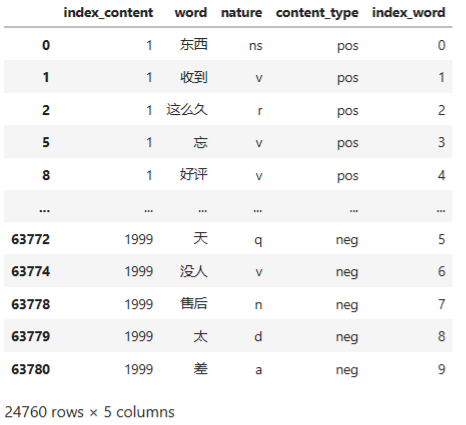第十二章——电商产品评论数据情感分析
1、评论去重的代码
import pandas as pd import re import jieba.posseg as psg import numpy as np # 去重,去除完全重复的数据 reviews = pd.read_csv("./reviews.csv") reviews = reviews[['content', 'content_type']].drop_duplicates() content = reviews['content']

2、数据清洗、分词、词性标注、去除停用词代码
# 去除去除英文、数字等 # 由于评论主要为京东美的电热水器的评论,因此去除这些词语 strinfo = re.compile('[0-9a-zA-Z]|京东|美的|电热水器|热水器|') content = content.apply(lambda x: strinfo.sub('', x)) worker = lambda s: [(x.word, x.flag) for x in psg.cut(s)] # 自定义简单分词函数 seg_word = content.apply(worker) # 将词语转为数据框形式,一列是词,一列是词语所在的句子ID,最后一列是词语在该句子的位置 n_word = seg_word.apply(lambda x: len(x)) # 每一评论中词的个数 n_content = [[x+1]*y for x,y in zip(list(seg_word.index), list(n_word))] index_content = sum(n_content, []) # 将嵌套的列表展开,作为词所在评论的id seg_word = sum(seg_word, []) word = [x[0] for x in seg_word] # 词 nature = [x[1] for x in seg_word] # 词性 content_type = [[x]*y for x,y in zip(list(reviews['content_type']), list(n_word))] content_type = sum(content_type, []) # 评论类型 result = pd.DataFrame({"index_content":index_content, "word":word, "nature":nature, "content_type":content_type}) # 删除标点符号 result = result[result['nature'] != 'x'] # x表示标点符号 # 删除停用词 stop_path = open("./stoplist.txt", 'r',encoding='UTF-8') stop = stop_path.readlines() stop = [x.replace('\n', '') for x in stop] word = list(set(word) - set(stop)) result = result[result['word'].isin(word)] # 构造各词在对应评论的位置列 n_word = list(result.groupby(by = ['index_content'])['index_content'].count()) index_word = [list(np.arange(0, y)) for y in n_word] index_word = sum(index_word, []) # 表示词语在改评论的位置 # 合并评论id,评论中词的id,词,词性,评论类型 result['index_word'] = index_word

4、提取含有名词的评论
# 提取含有名词类的评论 ind = result[['n' in x for x in result['nature']]]['index_content'].unique() result = result[[x in ind for x in result['index_content']]]

5、绘制词云
import matplotlib.pyplot as plt from wordcloud import WordCloud frequencies = result.groupby(by = ['word'])['word'].count() frequencies = frequencies.sort_values(ascending = False) backgroud_Image=plt.imread('./pl.jpg') wordcloud = WordCloud(font_path="C:\Windows\Fonts\STZHONGS.ttf", max_words=100, background_color='white', mask=backgroud_Image) my_wordcloud = wordcloud.fit_words(frequencies) plt.imshow(my_wordcloud) plt.axis('off') plt.show() # 将结果写出 result.to_csv("./word.csv", index = False, encoding = 'utf-8')

6、匹配情感词
import pandas as pd import numpy as np word = pd.read_csv("./word.csv") # 读入正面、负面情感评价词 pos_comment = pd.read_csv("./正面评价词语(中文).txt", header=None,sep="\n", encoding = 'utf-8', engine='python') neg_comment = pd.read_csv("./负面评价词语(中文).txt", header=None,sep="\n", encoding = 'utf-8', engine='python') pos_emotion = pd.read_csv("./正面情感词语(中文).txt", header=None,sep="\n", encoding = 'utf-8', engine='python') neg_emotion = pd.read_csv("./负面情感词语(中文).txt", header=None,sep="\n", encoding = 'utf-8', engine='python') # 合并情感词与评价词 positive = set(pos_comment.iloc[:,0])|set(pos_emotion.iloc[:,0]) negative = set(neg_comment.iloc[:,0])|set(neg_emotion.iloc[:,0]) intersection = positive&negative # 正负面情感词表中相同的词语 positive = list(positive - intersection) negative = list(negative - intersection) positive = pd.DataFrame({"word":positive, "weight":[1]*len(positive)}) negative = pd.DataFrame({"word":negative, "weight":[-1]*len(negative)}) posneg = positive.append(negative) # 将分词结果与正负面情感词表合并,定位情感词 data_posneg = posneg.merge(word, left_on = 'word', right_on = 'word', how = 'right') data_posneg = data_posneg.sort_values(by = ['index_content','index_word'])
7、修正情感倾向
# 根据情感词前时候有否定词或双层否定词对情感值进行修正 # 载入否定词表 notdict = pd.read_csv("./not.csv") # 处理否定修饰词 data_posneg['amend_weight'] = data_posneg['weight'] # 构造新列,作为经过否定词修正后的情感值 data_posneg['id'] = np.arange(0, len(data_posneg)) only_inclination = data_posneg.dropna() # 只保留有情感值的词语 only_inclination.index = np.arange(0, len(only_inclination)) index = only_inclination['id'] for i in np.arange(0, len(only_inclination)): review = data_posneg[data_posneg['index_content'] == only_inclination['index_content'][i]] # 提取第i个情感词所在的评论 review.index = np.arange(0, len(review)) affective = only_inclination['index_word'][i] # 第i个情感值在该文档的位置 if affective == 1: ne = sum([i in notdict['term'] for i in review['word'][affective - 1]]) if ne == 1: data_posneg['amend_weight'][index[i]] = -\ data_posneg['weight'][index[i]] elif affective > 1: ne = sum([i in notdict['term'] for i in review['word'][[affective - 1, affective - 2]]]) if ne == 1: data_posneg['amend_weight'][index[i]] = -\ data_posneg['weight'][index[i]] # 更新只保留情感值的数据 only_inclination = only_inclination.dropna() # 计算每条评论的情感值 emotional_value = only_inclination.groupby(['index_content'], as_index=False)['amend_weight'].sum() # 去除情感值为0的评论 emotional_value = emotional_value[emotional_value['amend_weight'] != 0]
8、查看情感分析的结果
# 给情感值大于0的赋予评论类型(content_type)为pos,小于0的为neg emotional_value['a_type'] = '' emotional_value['a_type'][emotional_value['amend_weight'] > 0] = 'pos' emotional_value['a_type'][emotional_value['amend_weight'] < 0] = 'neg' # 查看情感分析结果 result = emotional_value.merge(word, left_on = 'index_content', right_on = 'index_content', how = 'left') result = result[['index_content','content_type', 'a_type']].drop_duplicates() confusion_matrix = pd.crosstab(result['content_type'], result['a_type'], margins=True) # 制作交叉表 (confusion_matrix.iat[0,0] + confusion_matrix.iat[1,1])/confusion_matrix.iat[2,2] # 提取正负面评论信息 ind_pos = list(emotional_value[emotional_value['a_type'] == 'pos']['index_content']) ind_neg = list(emotional_value[emotional_value['a_type'] == 'neg']['index_content']) posdata = word[[i in ind_pos for i in word['index_content']]] negdata = word[[i in ind_neg for i in word['index_content']]] # 绘制词云 import matplotlib.pyplot as plt from wordcloud import WordCloud # 正面情感词词云 freq_pos = posdata.groupby(by = ['word'])['word'].count() freq_pos = freq_pos.sort_values(ascending = False) backgroud_Image=plt.imread('./pl.jpg') wordcloud = WordCloud(font_path="C:\Windows\Fonts\STZHONGS.ttf", max_words=100, background_color='white', mask=backgroud_Image) pos_wordcloud = wordcloud.fit_words(freq_pos) plt.imshow(pos_wordcloud) plt.rcParams['font.sans-serif'] = 'SimHei' # 设置中文显示 plt.axis('off') plt.show() # 负面情感词词云 freq_neg = negdata.groupby(by = ['word'])['word'].count() freq_neg = freq_neg.sort_values(ascending = False) neg_wordcloud = wordcloud.fit_words(freq_neg) plt.imshow(neg_wordcloud) plt.rcParams['font.sans-serif'] = 'SimHei' # 设置中文显示 plt.axis('off') plt.show() # 将结果写出,每条评论作为一行 posdata.to_csv("./posdata.csv", index = False, encoding = 'utf-8') negdata.to_csv("./negdata.csv", index = False, encoding = 'utf-8')


9、建立词典及语料库
import pandas as pd import numpy as np import re import itertools import matplotlib.pyplot as plt # 载入情感分析后的数据 posdata = pd.read_csv("./posdata.csv", encoding = 'utf-8') negdata = pd.read_csv("./negdata.csv", encoding = 'utf-8') from gensim import corpora, models # 建立词典 pos_dict = corpora.Dictionary([[i] for i in posdata['word']]) # 正面 neg_dict = corpora.Dictionary([[i] for i in negdata['word']]) # 负面 # 建立语料库 pos_corpus = [pos_dict.doc2bow(j) for j in [[i] for i in posdata['word']]] # 正面 neg_corpus = [neg_dict.doc2bow(j) for j in [[i] for i in negdata['word']]] # 负面

10、主题数寻优
# 构造主题数寻优函数 def cos(vector1, vector2): # 余弦相似度函数 dot_product = 0.0; normA = 0.0; normB = 0.0; for a,b in zip(vector1, vector2): dot_product += a*b normA += a**2 normB += b**2 if normA == 0.0 or normB==0.0: return(None) else: return(dot_product / ((normA*normB)**0.5)) # 主题数寻优 def lda_k(x_corpus, x_dict): # 初始化平均余弦相似度 mean_similarity = [] mean_similarity.append(1) # 循环生成主题并计算主题间相似度 for i in np.arange(2,11): lda = models.LdaModel(x_corpus, num_topics = i, id2word = x_dict) # LDA模型训练 for j in np.arange(i): term = lda.show_topics(num_words = 50) # 提取各主题词 top_word = [] for k in np.arange(i): top_word.append([''.join(re.findall('"(.*)"',i)) \ for i in term[k][1].split('+')]) # 列出所有词 # 构造词频向量 word = sum(top_word,[]) # 列出所有的词 unique_word = set(word) # 去除重复的词 # 构造主题词列表,行表示主题号,列表示各主题词 mat = [] for j in np.arange(i): top_w = top_word[j] mat.append(tuple([top_w.count(k) for k in unique_word])) p = list(itertools.permutations(list(np.arange(i)),2)) l = len(p) top_similarity = [0] for w in np.arange(l): vector1 = mat[p[w][0]] vector2 = mat[p[w][1]] top_similarity.append(cos(vector1, vector2)) # 计算平均余弦相似度 mean_similarity.append(sum(top_similarity)/l) return(mean_similarity) # 计算主题平均余弦相似度 pos_k = lda_k(pos_corpus, pos_dict) neg_k = lda_k(neg_corpus, neg_dict) # 绘制主题平均余弦相似度图形 from matplotlib.font_manager import FontProperties font = FontProperties(size=14) #解决中文显示问题 plt.rcParams['font.sans-serif']=['SimHei'] plt.rcParams['axes.unicode_minus'] = False fig = plt.figure(figsize=(10,8)) ax1 = fig.add_subplot(211) ax1.plot(pos_k) ax1.set_xlabel(' ', fontproperties=font) ax2 = fig.add_subplot(212) ax2.plot(neg_k) ax2.set_xlabel(' ', fontproperties=font)


11、LDA主题分析
# LDA主题分析 pos_lda = models.LdaModel(pos_corpus, num_topics = 3, id2word = pos_dict) neg_lda = models.LdaModel(neg_corpus, num_topics = 3, id2word = neg_dict) pos_lda.print_topics(num_words = 10) neg_lda.print_topics(num_words = 10)



